Recent Storm Damage Posts
Winter Storm Damage Restoration for Your Home in Central East Baton Rouge Parish
1/14/2025 (Permalink)
Winter storms can bring unexpected challenges to your home, such as frozen pipes, roof leaks, and water damage. SERVPRO of Central East Baton Rouge Parish is here to provide professional winter storm damage restoration services tailored to residential properties. Our experienced team responds quickly to assess the damage, remove excess water, and repair affected areas. We use advanced equipment and proven techniques to restore your home to its original condition efficiently.
Available 24/7, our goal is to minimize stress and disruption during this difficult time. Whether it’s water removal or addressing structural damage, you can count on us for prompt and reliable service. Protect your home this winter—trust SERVPRO of Central East Baton Rouge Parish for all your restoration needs!
Contact: (225) 275-7445
Weathering the Storm: Tips for Minimizing Water Damage During Severe Storms
1/9/2024 (Permalink)
Severe storms, with their torrential rains and relentless winds, pose a significant threat to homes and properties. One of the most common and potentially devastating outcomes of such storms is water damage. However, with proactive measures and strategic planning, you can minimize the risk of water damage and protect your home. In this blog, we'll explore valuable tips for safeguarding your property during severe storms and reducing the impact of water-related issues.
Maintain Gutters and Downspouts
Ensure that gutters and downspouts are clear of debris, leaves, and other obstructions. Regularly clean and inspect these components to facilitate proper water drainage away from your home. Consider adding gutter extensions to direct water even farther away from your home's foundation. This simple addition can prevent water from pooling near the base of your house during heavy rainfall.
Inspect and Repair Roof and Doors
Regularly inspect your roof for damaged or missing shingles. Address any issues promptly to prevent water from infiltrating your home during a storm. A well-maintained roof is a crucial defense against water damage. Ensure that windows and doors are properly sealed to prevent water intrusion. Weatherstripping and caulking are effective ways to reinforce these vulnerable areas and keep water at bay.
HVAC Equipment & Sump Pump
If possible, elevate outdoor HVAC equipment to a level that prevents flooding during storms. This not only protects the equipment but also minimizes the risk of water entering your home through ventilation systems. Consider installing a sump pump in your basement or crawl space. Sump pumps are effective in preventing water accumulation and can be a valuable asset during severe storms.
Grade Your Yard Away from the Foundation
Ensure that the slope of your yard directs water away from the foundation. Proper grading helps prevent water from pooling near the base of your home, reducing the risk of foundation leaks and water damage. Strategic landscaping can help manage water flow. Planting native vegetation and creating swales or berms can absorb excess water and prevent runoff toward your home.
Inspect and Repair Foundation Cracks
Regularly inspect your home's foundation for cracks and promptly address any issues. Sealing foundation cracks is crucial in preventing water from seeping into your home during storms. In flood-prone areas, store valuable items and important documents at higher levels within your home. This precaution can protect your possessions from potential water damage.
Install Flood Sensors
Invest in flood sensors that can detect water in vulnerable areas of your home. These devices can provide early warnings, allowing you to take swift action and minimize potential damage.
Create an Emergency Plan
Develop a comprehensive emergency plan that includes evacuation routes, emergency contacts, and procedures for turning off utilities. Being prepared for severe storms empowers you to act swiftly and protect your home.
Minimizing water damage during severe storms requires a combination of proactive measures and strategic planning. By fortifying your home's defenses and implementing these tips, you can build resilience against the forces of nature. Remember that preparedness is key, and taking action before a storm arrives ensures that you can weather the storm with confidence and protect your home and loved ones from the potential ravages of water damage.
Coping with Power Outages during a Storm
9/23/2023 (Permalink)
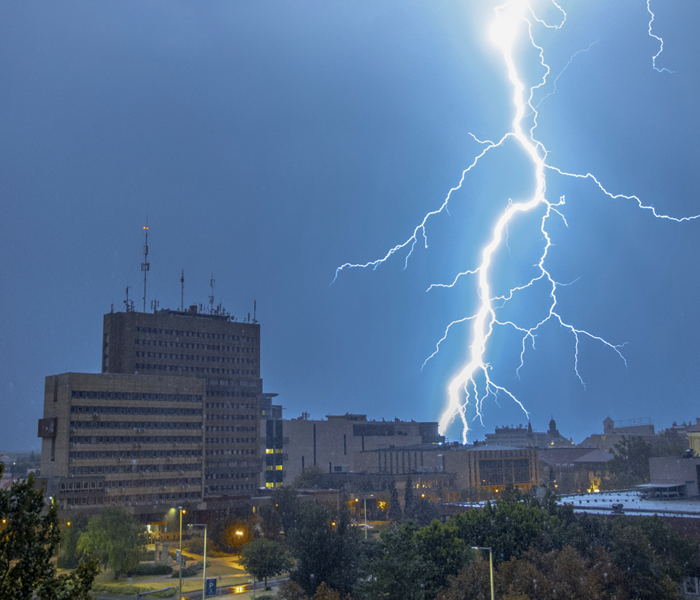 When storms leave you with power outages, ensure you have strategies to stay safe.
When storms leave you with power outages, ensure you have strategies to stay safe.
Power outages are a common occurrence during storms, and they can disrupt our daily lives and pose various challenges. Being prepared and knowing how to cope with power outages is essential for staying safe, comfortable, and connected during these challenging times. In this blog post, we will explore some practical tips and strategies for coping with power outages during storms.
Create an Emergency Kit
Having an emergency kit prepared in advance is crucial for dealing with power outages. Include essential items such as flashlights, extra batteries, a battery-powered radio, a first aid kit, non-perishable food items, bottled water, a manual can opener, and a backup power source, such as a generator or a battery pack for charging essential devices.
Stay informed by keeping a list of important phone numbers, including the local power company, emergency services, and any local updates provided by authorities. Consider downloading relevant apps or subscribing to emergency alert services to receive real-time information about the outage and any safety measures.
Minimize Power Usage
During a power outage, conserve energy by minimizing power usage. Turn off all non-essential lights, appliances, and electronics to reduce the strain on the electrical system when power is restored. Unplug sensitive devices to protect them from power surges when the power comes back on.
Keep the refrigerator and freezer doors closed as much as possible to maintain the cold temperature and preserve perishable food. If the outage is prolonged, consider moving essential items to a cooler with ice. Additionally, ensure you have an adequate supply of any necessary medications and keep them in a cool, dry place.
Stay Safe
Stay safe during a power outage by using caution. Keep candles and open flames away from flammable materials and never leave them unattended. If using a generator, follow the manufacturer's instructions and place it outside to prevent carbon monoxide poisoning. Use flashlights instead of candles whenever possible to reduce the risk of fire.
During a power outage, it's important to stay hydrated and comfortable, especially if the outage occurs during extreme weather. Have bottled water stored and use battery-operated fans or open windows for ventilation. If necessary, seek alternative shelter with friends, family, or emergency shelters to ensure your safety and well-being.
Maintain Communication
During a power outage, it's crucial to maintain communication with loved ones and authorities. Keep your mobile devices charged and use them sparingly to conserve battery life. Consider investing in a portable phone charger or a car charger as an additional power source. If cell service is unavailable, use a landline phone if possible.
Reach out to neighbors, friends, or community organizations to offer or seek assistance during a power outage. Check on vulnerable individuals, such as the elderly or those with medical conditions, to ensure their well-being. Sharing resources, expertise, and support can make coping with a power outage more manageable and less stressful.
Remember to be patient during a power outage. Restoration efforts can take time, especially during severe storms or widespread outages. Trust that the utility companies are working diligently to restore power as quickly and safely as possible. Coping with power outages during storms can be challenging, but with preparation, practical strategies, and a calm approach, you can navigate through these situations. By following these tips, you can minimize the impact of power outages, ensure your safety, and make the experience more manageable for yourself and your loved ones.
Crawlspace Chronicles: Conquering the Challenge of Removing 2 Feet of Water
6/12/2023 (Permalink)
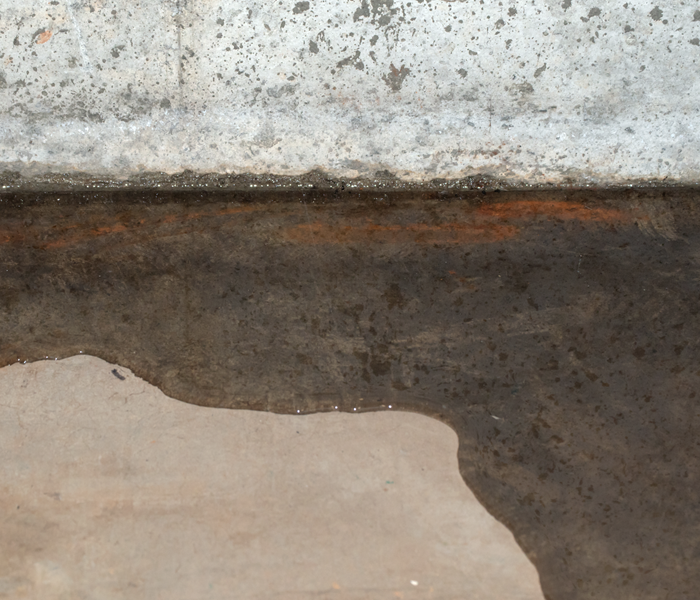 Removing water from a crawl space is crucial for preventing mold and secondary damages.
Removing water from a crawl space is crucial for preventing mold and secondary damages.
A flooded crawl space can be a homeowner's worst nightmare. Whether it's caused by heavy rainfall, a burst pipe, or a plumbing mishap, dealing with standing water in your crawl space requires immediate attention to prevent further damage. In this blog, we'll guide you through the step-by-step process of safely removing 2 feet of water from your crawlspace, helping you restore your home to a dry and secure state.
Step 1: Prioritize Safety
Before diving into the water removal process, ensure your safety by following these precautions. Turn off all electrical power in the crawlspace to avoid electrocution hazards. Wear protective clothing, including rubber boots, gloves, and a face mask to minimize contact with potentially contaminated water.
Step 2: Assess the Situation
Evaluate the extent of the water damage and identify the source of the flooding if possible. This will help you determine the best approach for removing the water. Additionally, take note of any valuable items or furniture that might have been affected and prioritize their recovery.
Step 3: Pumping out the Water
To remove the substantial amount of water from your crawlspace, you'll need to employ a reliable pump. Follow these steps:
- Rent or purchase a submersible pump capable of handling large volumes of water.
- Locate the lowest point in your crawlspace and position the pump there.
- Connect a hose to the pump and direct it away from your home's foundation, ensuring proper drainage.
- Plug in the pump and allow it to run until all the water has been pumped out. Be patient, as this process may take several hours.
Step 4: Drying and Ventilation
Once the water has been removed, focus on drying out the remaining moisture to prevent mold growth and further damage. Use a wet/dry vacuum or mop to remove any residual water from the surface. Open all doors, windows, and vents to promote cross-ventilation and increase airflow in the crawlspace. Place dehumidifiers and fans strategically throughout the space to expedite the drying process. Monitor humidity levels regularly and adjust the equipment as needed.
Step 5: Inspect and Repair
Once your crawlspace is completely dry, thoroughly inspect the area for any signs of damage. Look for structural issues, mold growth, and compromised insulation. Address these problems promptly by contacting professionals if necessary. Additionally, take preventive measures to avoid future water intrusion, such as repairing leaks, improving drainage systems, or installing a sump pump
Step 6: Clean and Disinfect
Even after the water is removed, it's crucial to clean and disinfect the crawlspace to eliminate any secondary damages. Scrub the walls, floor, and any affected surfaces with a solution of warm water and bleach or a specialized disinfectant. Dispose of any water-damaged materials, such as insulation or carpet, that cannot be effectively cleaned or salvaged. Use a mold inhibitor to further prevent mold growth in the future.
Removing water from a crawlspace is a challenging task that requires careful planning and execution. By following these steps and taking appropriate safety measures, you can effectively mitigate the damage, restore your crawlspace to a dry state, and prevent further issues like mold growth. However, if you're uncertain or the damage is extensive, it's always advisable to consult with professionals who specialize in water damage restoration to ensure a thorough and proper recovery process.
5 Essential Items to Have During an Emergency
12/7/2022 (Permalink)
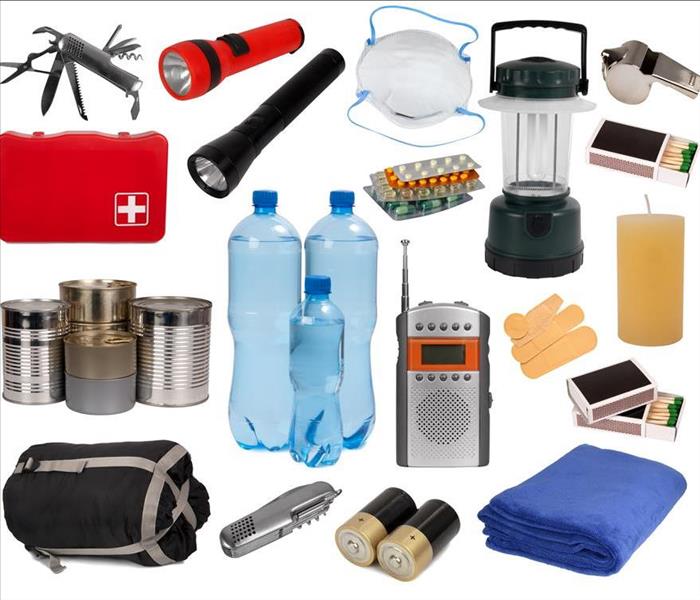 Create an emergency kit for yourself and your family.
Create an emergency kit for yourself and your family.
How To Prepare For An Emergency
You are reading this article because you want to know what essential items you should have on hand in case of an emergency. That's a good place to start. But it's also important to remember that emergencies don't always happen at convenient times or places—and they affect more than just your home and immediate family. So, think about how you can best prepare for an emergency by creating an emergency kit for yourself and your family, including pets if possible!
Food and Water
Food and water are essential to survival. It's best to store at least 72 hours worth of food and water per person, but if you can afford it, go ahead and stock up on more. This is especially important if you have children or elderly family members as well as pets or other animals—you should be prepared for them too!
Clothing and Bedding
Clothing should be comfortable, versatile and easy to put on. Bring layered clothing that will protect you from the elements, rather than just one or two pieces of clothing that you would need to change into if your home were to become inaccessible due to flooding or fire. Include shoes and socks so that the entire family has something warm with which to walk if necessary. A hat and gloves are also important because they can help keep your head warm in cold temperatures or protect it from sunburn on sunny days when there's no shade available for protection.
First-Aid Supplies
As you plan for an emergency, it’s important to be prepared with the right first-aid supplies. This can include a first-aid kit and other life-saving items such as bandages, tape, scissors, gauze pads and more. A basic kit should contain:
- Bandages of different sizes
- Adhesive tape in several widths
- Scissors for cutting the tape or fabric bandages
- Sterile pads like gauze dressing pads or sterile eye pad strips (for covering wounds on your face)
- Nonadherent dressings (these are adhesive dressings that do not stick to skin)
Tools and Emergency Supplies
Have a fire extinguisher and make sure that it is in working order. You can buy an inexpensive one at your local hardware store, or you could get one of the more expensive models that can be used on all kinds of fires.
If there is a fire, you should also have items for getting out of your house if necessary. This might include a flashlight and extra batteries for it, along with rope or string so you can make a rope ladder from the roof to the ground if needed. You may also want to have a first aid kit with some basic supplies like bandages and antibiotic ointment in case someone gets injured during an evacuation due to smoke inhalation or other problems caused by the fire itself (such as burns).
It's also important to keep extra batteries for any electronic devices such as phones or tablets because they may not work after an emergency situation due to power loss or network coverage issues caused by damage done during disasters such as floods or earthquakes."
Special Items
If you have a household member who requires special items during an emergency, be sure to include them in your kit. It’s important to keep medications on hand at all times, but in an emergency situation where there may not be accessible to a pharmacy or doctor, it’s more crucial than ever. In addition to medications for chronic conditions such as asthma and diabetes, having basic first aid supplies can make life much easier for those with special needs. If you have someone with limited mobility or sight (for example), the ability to move around independently might be even more important than usual.
Also consider including items that are necessary for children: diapers, formula, and baby food if applicable; blankets; books; games and activities that require little set-up time (think travel versions of popular board games). Make sure these are already packed before any kind of situation arises so everyone can focus on whatever crisis is happening outside their home instead of worrying about making sure they have everything they need inside their house too!"
Create a Disaster Plan
The more prepared you are, the greater chance you have of making it through an emergency unscathed. If you’re part of a larger community—for example, if there is an office or school nearby—you may also want to work together on creating a shared disaster plan.
The goods included in this kit will vary depending on what type of emergency it is that's being faced, but all essentials should be portable and easy to carry around with you if necessary (though not too heavy). Remember: food and water are vital!
If your home were hit by a natural disaster like fire or flooding, how would you take care of yourself? Can someone else take care of themselves? When the electricity goes out during a storm or earthquake, how do you cook food so everyone stays healthy?
A disaster can happen at any time, but you’ll be prepared if you have the right supplies on hand. As we know from experience, being prepared with a plan and supplies is essential to keeping your family safe during an emergency. We hope this article has given you some ideas about what to include in your own emergency kit so that everyone in your household is ready for anything life throws their way!
If your home or business is struck by fire, water, or storm, SERVPRO of Central East Baton Rouge is here to help you restore your Baton Rouge property back to its preloss condition.
How Does One File a Flood Claim Safely and Accurately?
7/20/2022 (Permalink)
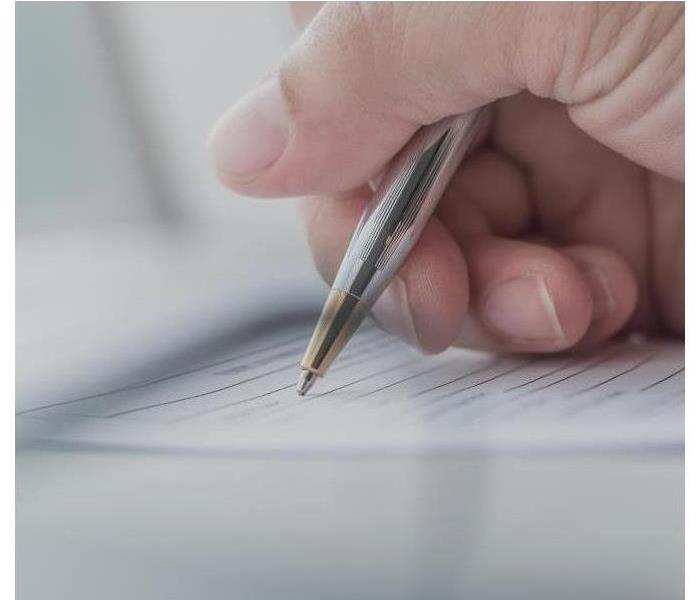 Complete your flood claim as thoroughly as possible
Complete your flood claim as thoroughly as possible
If your house in Zachary, LA, ever becomes flooded, you need to complete your flood claim as thoroughly as possible. Taking proper stock of the damage your home has suffered means an insurer is less likely to issue a denial.
Staying Safe
When conducting your assessment, it’s crucial that you minimize danger:
Always wear protection such as respirators, knee-high boots, and rubber gloves. You never want to risk exposing yourself to mold caused by the flooding.
Beware of potential electrical damage. Use only battery-powered sources for illumination to avert a nasty shock.
As much as possible, avoid entering floodwater. It may have become contaminated with gasoline or raw sewage.
Keep an eye out for critters. Snakes or insects might have washed into your home, so beware.
Remember that remaining out of harm’s way always comes first.
Making Your Claim
First, notify your insurer to begin the flood claim process. Next, take stock of the damage. This is the most important aspect of your insurance claim, as you need proof behind every piece of observable devastation. Maintain a detailed inventory of everything and take extensive photos. Never throw anything away, just in case you need to provide evidence.
Deploy action before an adjuster gets in touch; you can significantly speed up the claims process by handling matters ahead of time. Arrange your home so the adjuster may easily view every element of destruction. Also, post your contact information in a clearly visible spot so the adjuster can get in touch if questions arise. Once you have completed a Proof of Loss and received payment, you will then be free to reach out to a home repair expert that can return your residence to its previous state, making it look "Like it never even happened."
Inventorying a flood claim can be a challenge, but keep in mind that handling the matter properly means safety as well as proper compensation for any costs you have unfortunately incurred.
3 Steps To Take After A Sewage Backup
6/18/2022 (Permalink)
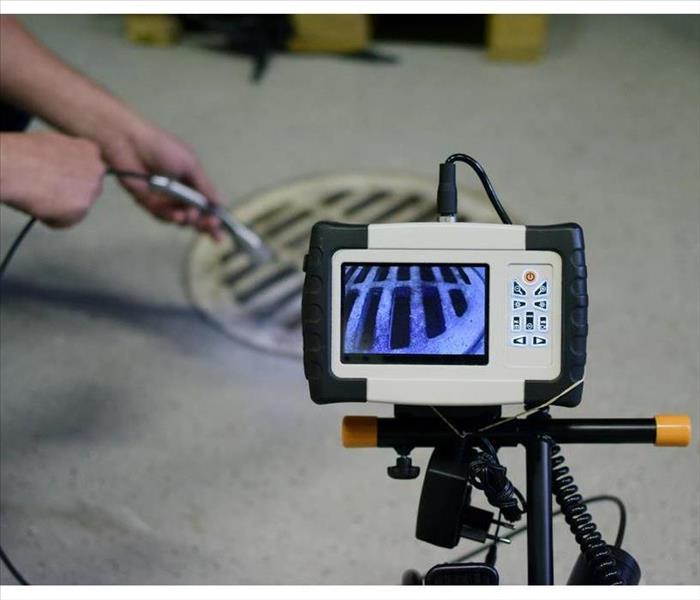 Plumbers will use a specialized camera that they place into the pipes and can locate the problem in the area.
Plumbers will use a specialized camera that they place into the pipes and can locate the problem in the area.
Three Steps To Take After A Sewage Backup
Whether you have a clogged main sewage pipe or your sewer system gets overwhelmed after a severe storm with significant floods, you could face a sewage backup. When that happens to your Monticello, LA, home, you need to know what to do to keep your family safe. Here are three steps to take after a sewage backup.
1. Call a Plumber To Determine Why the Sewer Backup is Happening
When you find a sewage backup in your home, you first want to call a plumber to determine why the sewer system has backed up. The plumber will use a specialized camera that they place into the pipes and can use to locate problem areas. If you have a clog, they will clear the clog at that time. If your system was overwhelmed by heavy rainwaters, you'll need your system pumped to prevent further problems.
2. Determine if the Area is Safe to Go Into
When dealing with a sewer backup, it's essential to evaluate the situation before you attempt to start cleaning up. If your problem is limited to a simple bathtub backup, you'll be fine to handle things yourself. Ensure that you use protective equipment and a bleach-water solution to clean and sanitize your bathtub. However, if the sewage spill is more widespread, always err on the side of caution and contact a water damage restoration company to clean up for you. The longer the sewage sits, the more widespread the damage will be, so contact a company as soon as possible.
3. Stop it From Happening Again
Regular maintenance of your system is vital to help prevent a sewer backup. Have a plumber scope your pipes and remove any buildups or clogs every year. If you have a septic system, ensure that you keep your gutters clean of debris to avoid flooding your drain field, which could cause your septic system to get overwhelmed.
Dealing with a sewage backup can be a stressful situation. However, following a few simple steps and relying on the pros will help you get your house back to normal in no time.
After a Flood: The Do’s and Don’ts
6/3/2022 (Permalink)
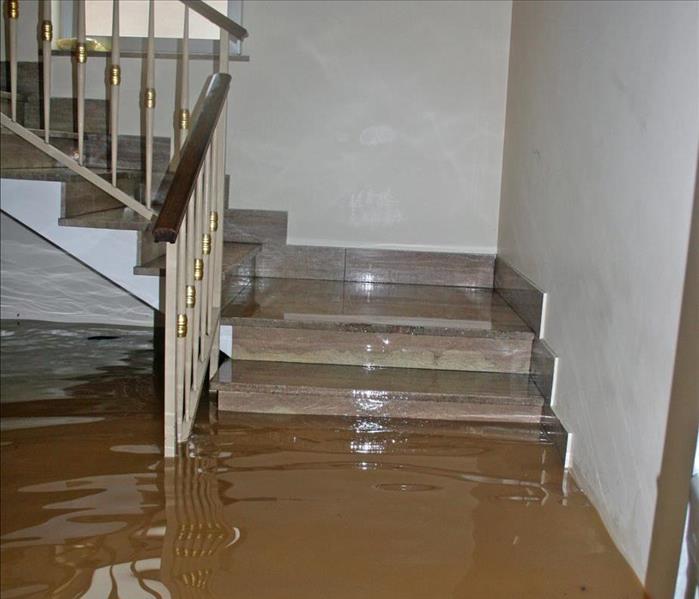 Flood damage in a home in Zachary, LA.
Flood damage in a home in Zachary, LA.
The Do's and Don'ts After a Flood
After a severe storm ravages Zachary, LA, safety should also come first. While you may be eager to determine the amount of damage your home has received from flood water, wind and other issues, some key things should and shouldn’t be done.
Flooded Home Do’s
If your home has sustained significant flooding, it is best to evacuate and not re-enter until it is deemed safe by the professionals. Once you have been given the go-ahead to re-enter, below are a few steps that should be taken next:
Document the damage for your insurance company. This includes taking videos and pictures, as well as retrieving important documents.
Any food, medicine or other consumables that have been touched by flood water should be discarded.
Verify that water is safe before drinking. If you are not certain, boil it beforehand.
Open doors and windows to get enhanced airflow.
Avoid using any electrical equipment that could have sustained damage.
If possible, begin extracting water and drying out affected areas.
Water Damage Don’ts
Knowing that safety is of the essence, avoid just imping in and tackling the water issues. If there is extensive water in the home, it is best to contact a certified mold, water and storm damage restoration company for an assessment and to handle the cleanup process. Stormwater often means that there are potential toxins, contaminants, microorganisms and other substances that will require specific safety gear and industrial-grade equipment. Water may also be lurking in hidden areas. Even if you think you have cleaned up a small issue, there could be mold starting to grow out of sight. When getting your home back to preloss condition is the priority, it’s best to let the experts handle the mess.
After the flood water starts to go down, it’s easy to want to rush in and start the cleaning process. Keeping safety in mind and following the above tips helps ensure the cleanup process goes safely and smoothly.
4 Tips for Preparing Your Business's Exterior for Storms
4/23/2022 (Permalink)
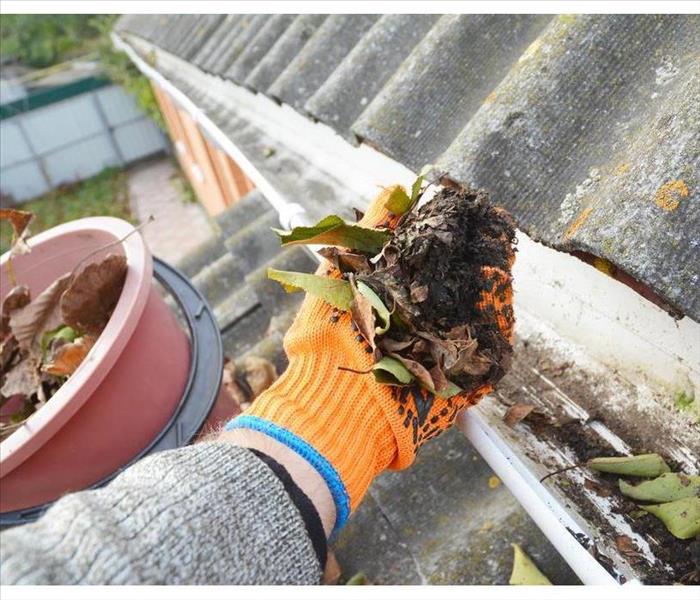 Keep your gutters clean.
Keep your gutters clean.
Four Storm-Proofing Tips for Your Business's Exterior
Your commercial business insurance and relevant riders are all lined up to carefully cover your company for this year's stormy season in Zachary, LA. Your employees are knowledgeable about all of your safety protocols, and you've inspected the interior of your site for vulnerabilities and moved all important documentation out of potential flood zones. How about exterior maintenance? While it might feel like a lost cause to try and perform any repairs or make improvements when big storms are imminent, protecting your building from the outside can make a big difference in how well it withstands a storm's lashing. Here are four tips.
1. Secure Loose Objects
Complete a thorough exterior building inspection, starting with loose objects that could be tossed by winds and cause more damage. Antennas, trash cans, hanging signs, and benches could all become projectiles that damage your building. Secure them outside or bring them indoors.
2. Protect All Glass
From individual windows to large glass storefronts, protect your business by using storm shutters. There are many types available at various price points. At the very least, use duct tape over the glass to prevent shattering.
3. Clean Out Downspouts
Cleaning downspouts, gutters, and drains is probably a part of your regular exterior maintenance routine, but going over them an extra time right before a big storm ensures that water can drain away from the building properly.
4. Look for Entry Points
Keeping your building maintained regularly ensures that you don't have huge repair projects right before a storm. Check the roof, windows, doors, and foundation for any possible points of entry for water. Plus, if you do have to call a water damage restoration company to help clean up after a storm, you can be sure that the damage was a result of the storm and not poor maintenance.
Exterior maintenance of your building is an important part of your storm preparedness plan.
Protecting Your Business From Flood Damage
4/5/2022 (Permalink)
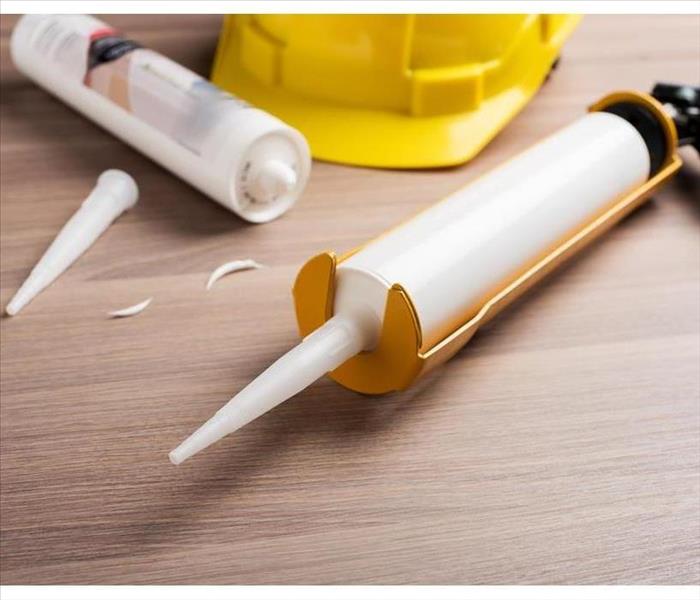 You can also help protect yourself by sealing any cracks in the outside of your building.
You can also help protect yourself by sealing any cracks in the outside of your building.
Flood Damage Protection for Your Business
If you own a business, you know you need to protect your building from flood damage. Fortunately, there are a few ways that you can do this in Baton Rouge, LA.
Have a Plan
One of the most important ways you can protect your business from a flood is to have a clear plan for what happens if it is going to flood. This plan should:
- Be comprehensive
- Encompass before and after the flood
- Have vital information on what to do
Keep your flood plan on-hand or in an accessible place.
Keep Vital Information On-Hand
You will need to keep important information like insurance policies and the number of a storm damage remediation company in a separate location. This can help you get things started even before the floodwaters recede.
Prepare for Flooding
You can prepare for flooding by keeping some flood supplies on hand. You can easily store absorbant flood barriers and plastic sheeting.
Keep Electricity Away From Water
Whenever possible, move your electrical outlets to water safe heights. You should also keep all electronics like computers and printers off the floor. If it is safe and you suspect that it might flood, consider shutting down the power to any electronics and unplugging them. This will help to protect them against flood damage.
Use Flood-Resistant Landscaping and Materials
If you have the choice, choose flood-resistant materials to decorate your office. Most of these materials can survive around 72 hours in the event of a flood. This can save you time and money when you want to return to normal business operations.
Decorate your premises with native landscaping. Native plants help provide a barrier and can survive a flood if it is something normal for your area.
Seal the Cracks
By using water-resistant materials, you can also help protect yourself by sealing any cracks in the outside of your building. This will keep water from seeping in.
Protecting yourself against flood damage is important in all areas. If you follow these suggestions, they can help you get back to business faster.




 24/7 Emergency Service
24/7 Emergency Service







